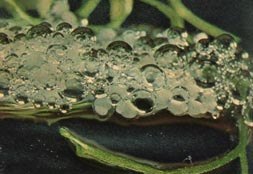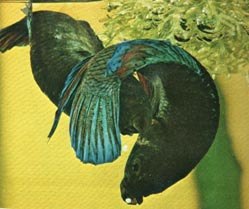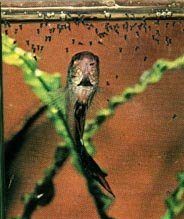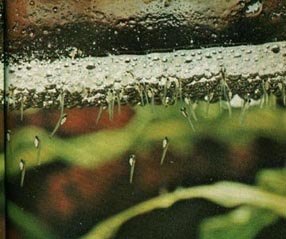
Submitted articles

BREEDING BETTAS.
By Kick
kick@bright.net


I have kept and bred Bettas for quite some time. Many Betta keepers have asked me over and over on the correct way to do this for a successful spawn. These instructions should provide you with enough information to accomplish just that. Happy Betta Breeding!

The Breeding Pair:
make sure that the male and female are relatively the
same size. Females are usually somewhat smaller than the males, but do not
try to breed a very young male/female with a much older mate. Someone will
get hurt.
Condition the Pair:
feed well, preferably live food (brine shrimp) and keep
their water very clean. Allow the two to see each other for a couple of days
and then remove the female from the male's site before placing him in the
breeding tank.
Breeding Tank:
small tank (I use 5 l/2 gallon) with approximately no more
than 4-5 inches of "conditioned" water; a corner sponge filter; submersible
heater set at 80; a plastic lid or piece of Styrofoam cup cut for the
bubblenest; and plastic or live plants so the female can hide when needed.
Do not have any rocks or substrate in this tank. Put the male in first. Let
him get used to his surroundings for about an hour or so. Then introduce the
female by putting her in a hurricane globe so the male can't get to her
right away. They should show some interest in one another, and he should
flare at her and start working on the bubble nest. (I had the experience a
couple of times that the female was already full of eggs and very shortly
after introducing her into the globe and seeing the male, she started to
release her eggs very quickly. She had been bred several times before with
the same mate. I released her immediately and the spawn began.)

Breeding:
When the bubblenest is fair size, and she displays vertical stripes and
stands "on her head" in the globe, you release her. Also look for her
"breeding tube" to be protruding. It is visible behind the pelvic fin. There
can and will probably be some nipping and chasing during this time. As long
as they are not sparing too badly, leave them alone. If one or the other is
being torn up very much, they are not ready. Put her back in the globe. Some
sparring will occur as this is the ritual of their mating but should not be
permitted to last for great length of time. The process of the pair "being
ready" can take from l hour to 4 or 5 days.
When they are ready, he will "entice" her to the nest, and she will
eventually follow. The mating process can take anywhere from 1 hour to 4 or
5 hours. He will "embrace" her, squeeze the eggs out, and the eggs will fall
to the floor of the tank. She will look like he has killed her, being very
still and motionless for a few seconds, like in a trance. He will "catch" or
pick up the eggs from the floor of the tank and "blow" into the bubble nest.
(I had one pair that the male would not have anything to do with the eggs,
and the female was the one who picked up eggs and put into the nest.)
When the spawning is complete, she will swim away from the male and "hide".
He usually won't bother her as he is busy picking up eggs that fall from the
nest. When spawning is done, remove her immediately (taking care not to
disturb the nest) as she may become interested in the "eggs" and start
eating them. The eggs are white and are a little bigger than a grain of
salt. You will probably need a magnifying glass to see them hanging from the
bubble nest.

Raising the Fry:
After the spawn and removing the female, you need to treat both she and the
breeding tank with Maroyx. This prevents infection to her from any torn
fins, and is needed in the breeding tank to keep fungus from developing in
the eggs. You also need to cover the tank with plastic wrap or glass so that
no "cooler" air is at the surface of the tank. When the fries' labyrinth
starts to develop (at about 5 to 7 weeks), and they come to the surface for
air, they can get pneumonia and die from the cooler air. I leave the cover
on the tank for the duration, until they are moved to jars or taken to the
pet store for selling.
Start an infursoria culture with lettuce and water or have on hand
"microfood" to have something to feed the fry when they are ready. At first
the fry will "live" off the yolk sac and do not need any food. Start to feed
about 2 days after they hatch or when they become free swimming.
In about two weeks, you will need to start feeding either live bbs (you can
set up your own hatchery) or microworms (which are started from a culture
and not ordinarily found in petstores) to feed the fry. The microworms are
easier to keep as the live bbs shrimp only last about 5 days after hatching.
You need to keep two hatcheries going so there is a constant supply of food
for them. They will need to be fed about every 4 hours or so, small portions
at a time.
At about 36 hours after the spawn, you will notice little "black dots" with
tails falling out of the nest to the bottom of the tank. The male will
studiously go to the bottom of the nest, retrieve the "fry" and "blow" them
back into the nest. When the fry become a little more free swimming in the
horizontal position, you can remove the male from the tank. It is also
possible to remove him earlier if he is not a good caretaker, eating the
fry. This is where you really need to pay attention as to how many fry you
have as he will be a good poppa at first, and the next minute eating every
one he picks up. If you must remove him, the fry will land on the bottom of
the tank and be okay there until they become free swimming.

You need to keep their water clean during the time they are growing up. Use
a very small plastic tube attached to air tubing or a turkey baster to suck
up the debris from the bottom of the tank. Run the water into something
clear so that you can look for and retrieve any fry that may have gotten
sucked up the siphon. Catch with white plastic spoon (so you can see them)
and replace back in the tank. Water replacement "has" to be the same temp so
as not to "chill" the fry and be conditioned to remove chlorine and
chloramines.

Betta fry are very, very tiny when hatched, and are very slow growing. Even after almost 3 months, they are still very little. It takes approximately 30 weeks for them to develop any color or have any size to them. They are usually not very active and most will basically sit on the bottom of the tank until feeding time. As they grow, you must pay close attention to them. As the males get older, you will notice them becoming aggressive with each other. This is when the males will need to be removed from the tank and "jarred". And this is where even more work will be involved. You need to have on hand many mason jars for the males, and these will all need to be cleaned on a regular basis. (I have had at times over 50 mason jars sitting around my house with these little fish in them.) The females will be okay together. As time progresses and the fry become larger, you can add water to the tank to bring it up gradually to being full. If there are quite a few female fry, they may need to be moved to a larger tank so as to not overcrowd them.
You may notice that after removing the male from the spawning tank, he
"acts" weird. He may be very tired from protecting and retrieving the fry or
even be "depressed" because his work is finished. Feed him well, add
"aquarium" salt to his water (l teaspoon per l gallon of water) and in a few
days, he should be back on track.
You may also notice after a pair has spawned, that very shortly they are
ready to go at it again. If you have the room and proper setup, you can
repeat the spawning, however, you should wait at least 2 weeks if possible
so as not to wear the pair out. If you have your hands full with the spawn
you already have, don't worry about breeding again. She may release her
"unfertilized" eggs and he may build bubble nests, but neither of these
activities will hurt them.
conclusion:
I think that just about covers the process of breeding these fish.
Sometimes, you can just put the two together and immediately have a spawn,
but don't hold your breath. My first spawn took several days, happened while
I was away and was not quite sure there had been a spawn until I saw the fry
falling from the nest. I was fortunate enough, however, to catch them during
the act one afternoon and have the whole beautiful process on tape. Mother
Nature works hard on making us look like fools, you know. But my son got an
A+ on a report he did for his 8th grade Science class!!!


|
|

Email: badman2nd@hotmail.com